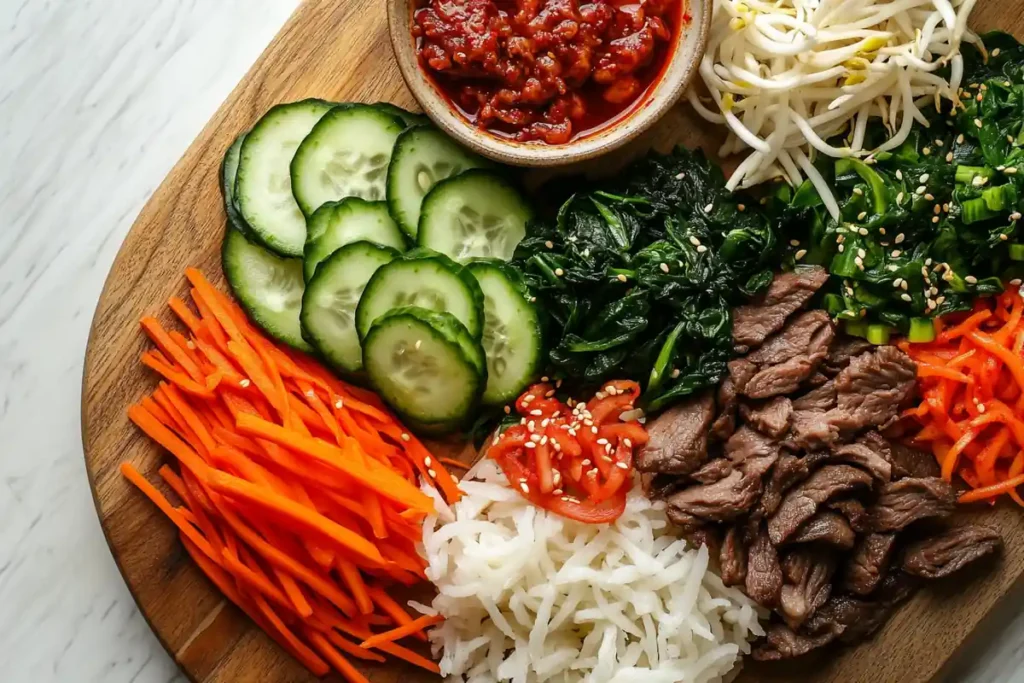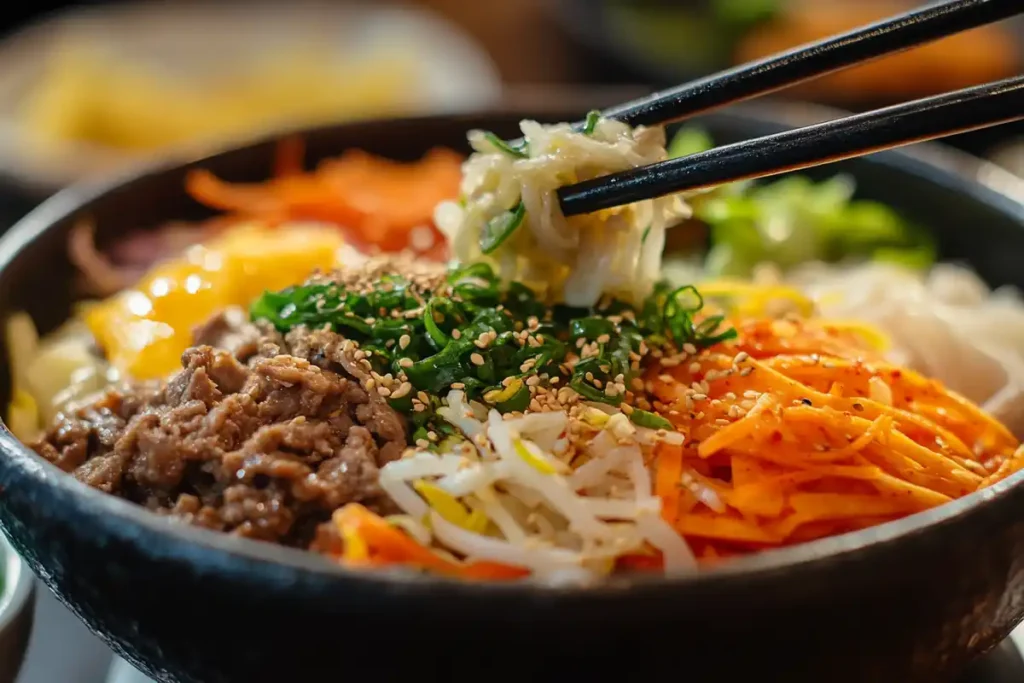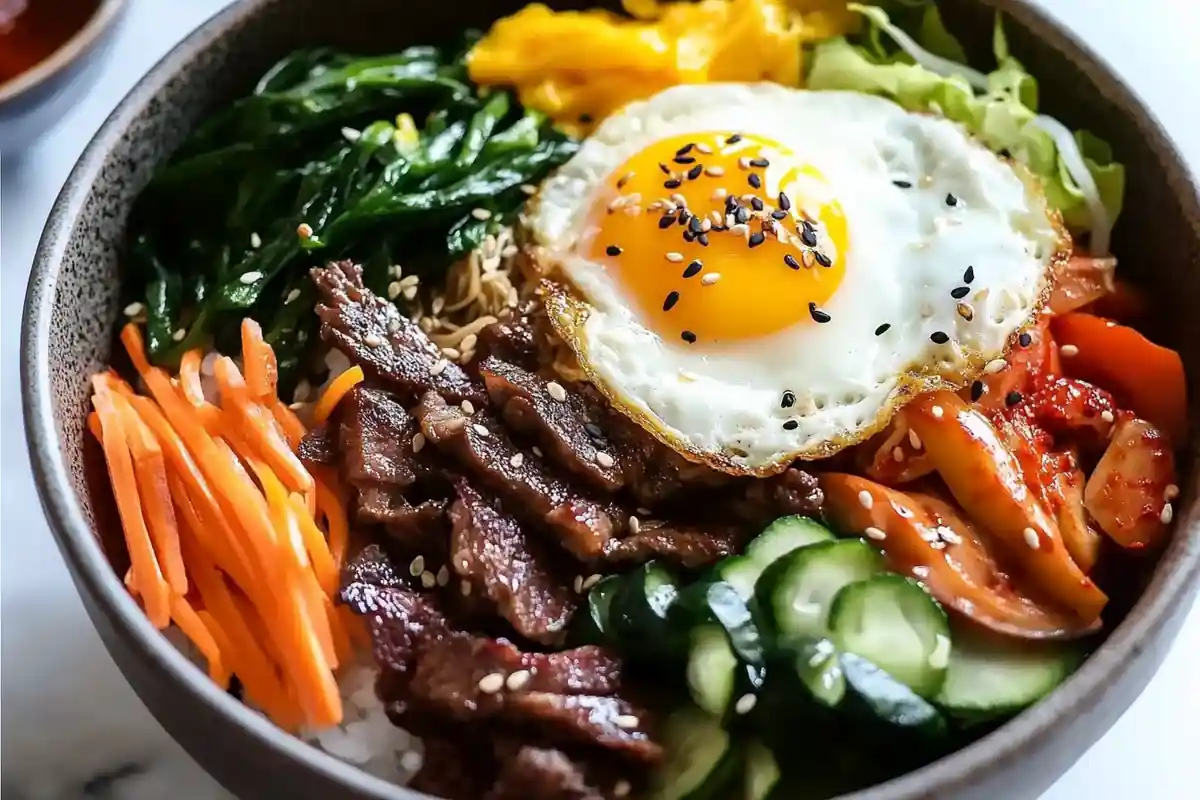Bibimbap, a vibrant and flavorful mixed rice dish, is an iconic symbol of Korean cuisine. This comprehensive guide will equip you with everything you need to create authentic bibimbap at home, from understanding its rich history to mastering a flexible bibimbap recipe. Whether you’re a seasoned chef or a beginner, get ready to embark on a culinary adventure! If you love hearty and comforting meals, you might also enjoy this Easy Smothered Potatoes Recipe—another satisfying dish packed with flavor.
What is Bibimbap?
Bibimbap, literally “mixed rice with meat and assorted vegetables,” represents the heart of Korean culinary heritage. Its vibrant colors and diverse ingredients symbolize balance and harmony. A traditional bibimbap features steamed rice topped with sautéed and seasoned vegetables, marinated meat (often bulgogi—thinly sliced beef), a fried egg, and gochujang (fermented chili paste). The combination of flavors and textures creates a symphony of tastes.
To enhance the flavors of your bibimbap, consider adding a sprinkle of homemade tomato salt—a simple yet powerful way to elevate the dish with an extra umami kick. And if you enjoy rice-based dishes with a variety of proteins, you may also love this Fried Rice with Egg, Chicken & Shrimp Recipe for another delicious way to enjoy a satisfying meal.
Essential Ingredients for a Perfect Bibimbap
Creating this perfect dish begins with fresh, high-quality ingredients. While the following list provides a foundation, feel free to adapt it to your preferences and dietary needs.
| Ingredient | Amount | Notes |
| Short-grain rice | 1 cup | Rinse thoroughly. |
| Bulgogi (beef) | ½ lb | Thinly sliced; substitute with chicken or tofu. |
| Spinach | 1 bunch | Blanched and seasoned. |
| Bean sprouts | 1 cup | Lightly sautéed. |
| Carrots | 1 medium | Julienned and sautéed. |
| Zucchini | 1 medium | Julienned and sautéed. |
| Shiitake mushrooms | ½ cup | Sliced and sautéed. |
| Gochujang | 2 tablespoons | Adjust to your spice preference. |
| Egg | 1 | Fried sunny-side up (optional). |
| Sesame oil | 1 tablespoon | For seasoning. |
| Soy sauce | 1 tablespoon | For marinating and seasoning. |
| Garlic | 2 cloves | Minced. |
| Ginger | 1 teaspoon | Grated. |
| Sugar | ½ teaspoon | For the bulgogi marinade. |
Now that you’ve gathered your fresh ingredients, let’s take a look at the nutritional benefits a well-balanced bibimbap recipe offers.
Bibimbap Nutrition: A Wholesome and Delicious Meal
Approximate Nutritional Information (per serving, based on a common recipe using beef, white rice, and typical vegetables):
| Nutrient | Amount (approximate) | % Daily Value (DV) |
| Calories | 600-700 | 30-35% |
| Total Fat | 25-35g | 32-46% |
| Saturated Fat | 7-10g | 35-50% |
| Cholesterol | 150-200mg | 50-67% |
| Sodium | 800-1200mg | 35-52% |
| Total Carbohydrate | 70-80g | 23-27% |
| Dietary Fiber | 5-7g | 18-25% |
| Total Sugars | 6-8g | — |
| Protein | 25-30g | 50-60% |
Important Considerations:
- Portion Size: This nutritional information is an estimate and can vary. Be mindful of your portion sizes to manage calorie intake.
- Ingredients: The type and amount of protein, vegetables, and sauce used significantly impact nutritional values. Using leaner meats, more vegetables, and less gochujang can make the dish healthier.
- Rice: Using brown rice instead of white rice increases fiber and nutrient content.
- Sodium: Bibimbap can be high in sodium, primarily due to gochujang and soy sauce. Use these ingredients sparingly or look for lower-sodium versions.
- Oil: Be mindful of the amount of oil used during cooking.
Step-by-Step Instructions

- Prepare the Rice: Rinse the short-grain rice thoroughly. Cook according to package directions until fluffy.
- Prepare the Vegetables: While the rice cooks, prepare the vegetables. Sauté each separately.
- Blanch spinach and season with sesame oil and garlic.
- Julienne carrots and zucchini and stir-fry until tender-crisp.
- Lightly sauté bean sprouts with soy sauce.
- Sauté sliced shiitake mushrooms until tender.
- Prepare the Bulgogi (or Protein): Marinate thinly sliced beef in soy sauce, sesame oil, garlic, ginger, and sugar. Stir-fry until caramelized. For a vegetarian option, use marinated tofu or tempeh.
- Assemble Your Bibimbap: In a bowl or hot stone pot (dolsot – for a crispy rice layer), layer rice, vegetables, bulgogi (or protein), a fried egg (optional), and gochujang.
- Mix and Enjoy: Just before serving, mix thoroughly. For a truly Korean experience, pair your bibimbap with traditional Korean drinks (see our article for suggestions).
Ketty’s Expert Tips and Creative Bibimbap Variations

Making this dish is already easy, but these tips and variations will help you create a truly authentic and delicious experience:
- Gochujang – Your Spice Navigator: Gochujang, Korean chili paste, is the heart and soul of bibimbap. Using a good quality gochujang is crucial for the best flavor. If you’re unsure which brand to choose, look for one with a deep, rich color and a balanced sweet and spicy flavor. Don’t be afraid to experiment with different brands to find your favorite. If you prefer a spicier bibimbap, add more gochujang. For a touch of sweetness, mix a small amount of honey or brown sugar into your gochujang before adding it to the bowl.
- Fresh Vegetables – A Rainbow of Flavor and Nutrition: Fresh, seasonal vegetables bring vibrancy and nutrients to your bibimbap. Think beyond the traditional spinach, bean sprouts, and carrots. In the spring, try incorporating tender asparagus spears or sweet peas. During the summer, add juicy sliced tomatoes, crisp cucumbers, and vibrant bell peppers. In the fall, consider roasted sweet potatoes or butternut squash for earthy sweetness. And in the winter, add hearty greens like kale or bok choy for added depth and warmth. Remember to cut the vegetables into bite-sized pieces for easy mixing and eating.
- The Egg – A Crowning Touch (or Not!): While a fried egg, cooked sunny-side up, is the classic topping for bibimbap, feel free to get creative. A perfectly poached egg offers a lighter option, while a soft-boiled egg, gently cracked over the bibimbap just before mixing, adds a creamy richness. If you’re watching your cholesterol or prefer a vegan bibimbap, you can omit the egg entirely or use a vegan egg substitute.
- Protein Power Plays – From Beef to Beyond: Bulgogi, thinly sliced marinated beef, is the traditional protein in bibimbap, but there’s a world of other delicious options. Marinated chicken or pork, thinly sliced and stir-fried, offer familiar alternatives. For seafood lovers, pan-seared shrimp or scallops bring a delicate sweetness to the dish. For vegetarians and vegans, marinated tofu or tempeh are excellent protein sources. You can even use crispy pan-fried mushrooms for a satisfying umami depth. Be sure to cook your protein of choice thoroughly before adding it to the bibimbap.
Tips for a Healthier Bibimbap Recipe
- Load Up on Vegetables: Increase the variety and quantity of vegetables for added vitamins, minerals, and fiber.
- Choose Lean Protein: Opt for lean beef, chicken breast, or fish. Plant-based proteins like tofu and tempeh are also excellent choices.
- Mind the Gochujang: Use gochujang sparingly to reduce sodium intake. You can also find lower-sodium versions.
- Brown Rice Power: Substitute brown rice for white rice to boost fiber and nutrient content.
- Healthy Fats: Use a small amount of heart-healthy oil like sesame oil or olive oil for cooking.
- Portion Control: Be mindful of your serving size to manage calorie intake.
By making these adjustments, you can enjoy a delicious and nutritious bibimbap that fits your dietary needs and preferences. For more detailed nutritional information, consult a nutritionist or use a nutrition calculator with your specific recipe ingredients.
FAQs
What are the core ingredients of bibimbap Recipe?
The foundation of this dish consists of rice, an assortment of sautéed vegetables, a protein source (traditionally beef, but often substituted with chicken, tofu, or other options), a fried egg (optional), and gochujang (Korean chili paste). Additional ingredients like sesame oil, garlic, and ginger enhance the flavor profile.
What’s the key difference between bibimbap and gimbap?
While both dishes utilize rice and vegetables, their preparation and presentation differ significantly. Bibimbap is a mixed rice dish served in a bowl, where all ingredients are combined before eating. Gimbap, on the other hand, involves rolling seasoned rice and various fillings in seaweed sheets, similar to sushi.
Is bibimbap a healthy meal choice?
Generally, bibimbap offers a good balance of nutrients, including carbohydrates from rice, vitamins and minerals from the vegetables, and protein from the meat or tofu. However, the sodium content can be relatively high due to the gochujang and other seasonings. Adjusting the amount of these ingredients can help control sodium intake.
What’s the easiest way to make bibimbap at home?
For a simplified approach, use pre-cut vegetables, pre-cooked rice, and pre-marinated meat. This can significantly reduce preparation time.
Which vegetables are traditionally included in bibimbap?
Common vegetables include spinach, bean sprouts, carrots, zucchini, mushrooms (such as shiitake), and ferns. However, feel free to customize with your favorite vegetables or what’s seasonally available.

